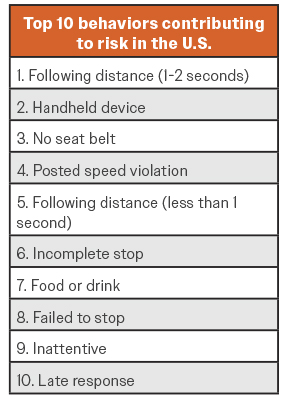Jeff Martin is the vice president of global sales strategy for Lytx Inc., a global leader in video safety and video telematics. Jeff has decades of operational experience in architecting, directing, and continuously improving safety programs.
MWS: Tell us about Lytx’s recent “State of the Data” report and what the report found in identifying over 18 million risky driving incidents in 2023.
MARTIN: Lytx’s 2024 “State of the Data” is powered by 40 billion miles of new driving data from 2023 to analyze and identify increased levels of risk on the roads to help fleets decrease unsafe driving behaviors. Notable findings from this year’s report highlight that as roadway risk increases, the importance of knowing how to drive safely, and the understanding of the risks associated with when and where to drive, become more vital and can play a significant role in overall fleet safety.
Captured roadway risk went up by 9.5 percent in 2023 from the previous year as traffic volume on U.S. roads grew to a record 3.26 trillion miles, according to the Federal Highway Administration. Using the proprietary Lytx Risk Score, which calculates behavior averages across a variety of industries using learnings from 261 billion miles of driving data from Lytx’s global database, the report found that the Lytx Risk Score per vehicle increased to 13.4 in 2023, from 12.9 in 2022.
The report also identified the top five riskiest public roadways, with over half near airports. JFK International in New York was the riskiest, followed by Phoenix Sky Harbor International and Reno-Tahoe International. Interestingly, the data within the report also identified roadways surrounding the Phoenix Convention Center and the Greater Columbus Convention Center as the fourth and fifth riskiest, respectively. Lacking familiarity with roadways, exits, and intersections, plus added distractions, and congestion, are likely key factors for the increased risk.
As for the riskiest states, California was number one, followed by New York, Texas, Florida, and Pennsylvania. Of note, California has been the riskiest state three times in the last four years. The riskiest U.S. cities were not a huge surprise given the population, number of motorists, and infrastructure of the roadways: New York City was number one, followed by Los Angeles, Chicago, Atlanta, and Boston. Regarding notable movers in this list, Atlanta moved up from number seven to number four, while Philadelphia moved down from number two to number eight when comparing 2023 data to the previous year.

MWS: What behaviors most commonly contribute to roadway risk, and are there peak times or days when there is heightened driver risk?
MARTIN: The top four risky driving behaviors identified were following too closely, handheld device usage, no seat belt, and speeding. A following distance of one to two seconds remained as the top risky behavior from the prior year and unfortunately, handheld device or cell phone usage rose one slot to number two from 2022. On the positive side, seat belt usage improved to number three and speeding remained consistent at number four. Identifying and understanding these driving risks creates a greater urgency for fleets to decrease unsafe driving behaviors through state-of-the-art video safety and video telematics solutions.
The afternoon drivetime between 4 p.m. to 7 p.m. is shown to be the riskiest and mornings between 5 a.m. and 8 a.m. were the safest. Of note, Lytx’s data showed that afternoon commute hours are three times riskier than the morning commute hours. For the riskiest days of the week, Wednesday had the highest number of collisions per vehicle, followed by Thursday. When it comes to holiday driving, sadly, Christmas Day is the riskiest holiday while Halloween was safest.

MWS: The report revealed near collisions were up 97 percent from 2022 to 2023 and actual collisions were up three percent from 2022 to 2023. What advice do you have when it comes to safety, protecting their lives and assets, and utilizing a safety and coaching program?
MARTIN: All fleet managers are encouraged to review the data and understand that in most cases, the challenges are similar and consistent with the rest of the motoring public. Today’s top companies and owner operators want to understand and prevent unsafe behaviors on the roadways, and one way to do that is to understand where your top risks are within your fleet.
Once understood, this allows for coaching and measured improvements to reduce risk, frequency, and costs not only in safety, but also improved fleet maintenance costs, fuel costs, greater efficiencies of trips and routes, and ultimately better customer service that can improve bottom lines.
Managers need to consider their crown metrics and what is most important behaviorally to measure, manage, and focus upon with their drivers. Keep it simple – make them reasonable, achievable, and most importantly, measurable. Today’s top video safety and telematics systems provide valuable data and insights to help companies understand opportunities, track progress, and realize savings. Most importantly, it helps to educate and safeguard professional drivers and fellow motorists that share the roadways together.

MWS: Did the report reveal any industries that are particularly prone to risk or collisions?
MARTIN: When it comes to near collisions, all industries saw an increase from 2022 to 2023. The largest increases came from the automotive sector (plus 226 percent), followed by concrete (plus 148 percent), and then emergency medical services (EMS) (plus 131 percent). In looking at the numbers, this suggests that even as roads were riskier than ever, commercial drivers are doing a much better job driving defensively and avoiding collisions on a per mile basis because they’re utilizing video safety technology and/or performing defensive driving skills.
Regarding collisions being up three percent in 2023, the concrete (plus 49 percent) and utilities (plus 14 percent) sectors showed the biggest increases, while the field services (down eight percent) and EMS (down five percent) industries saw the greatest decreases in collision frequency and severity in 2023. This is quite impressive for the field services sector as many refer to their drivers as “industrial athletes” who work outside of the cab most of the day, yet still have the task of driving safely and defensively.

MWS: If a fleet is interested in operating more sustainably, is video telematics and coaching a good place to start?
MARTIN: Absolutely. While safety is the North Star for most fleets, sustainability and having responsible operating standards are also extremely important. Video safety and video telematics solutions provide operators with the ability to institute, manage, and produce desired outcomes. For example, Lytx clients were able to decrease vehicle idling time and fuel waste by 12 percent in 2023, with an 8.3 percent drop in unnecessary idling time. Further, this led to more than 416 million pounds of CO2 emissions and nearly $88 million in wasted fuel being prevented from decreased idling in 2023.
In terms of cost savings, Lytx helped customers save an estimated $1.7 billion on claims in 2023, which includes workers compensation and insurance claims. Additionally, an estimated $493 million was saved on vehicle maintenance and an estimated savings of $678 million on fuel. For fleets interested in moving to more sustainable operations, a combination of efficient vehicles, optimized logistics, and better driver training can reduce up to 50 percent in emissions.
MWS: What are the ways in which Lytx is innovating new technologies to help fleet owners operate safely today?
Lytx’s video safety and video telematics solutions provide customers with a measurable advantage in delivering not just big data, but “best data.” It’s essential in today’s business climate to not only leverage a company’s safety culture and performance, but also their efficiency, fleet compliance, customer service, and ultimately their operating excellence. This includes integrating video safety technology so that drivers can self-correct in the moment and/or provide coaching opportunities with supervisors for consensus building discussions on improvement and recognition opportunities. The video telematics opportunity is vast. From fleet tracking to DVIR compliance and effectiveness, it positions all facets of the business to operate with the best data to achieve the desired outcomes.
For More Information
To learn more, visit www.lytx.com.
To read the full “State of the Data” report, visit: www.lytx.com/ebook/2024-state-of-the-data-report




